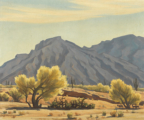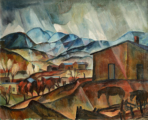In popular imagination, desert climates are often stark — dusty, barren wastelands of lifeless, parched earth. Over the years, writers, artists and filmmakers have portrayed the desert as a metaphor for emptiness and death. All too often, deserts are defined only by what they lack.
But there is another side to the story. For millennia, the dry climates of the American Southwest have been home to flourishing civilizations, unique architecture and sophisticated arts. Far from a place of emptiness, this desert is full of life with a rich cultural heritage. Beginning in the early 20th century, after railroads made the Southwest increasingly accessible for travelers, modern American painters began to recognize the distinct beauty of this place. In their work, the brilliant colors of the changing seasons reveal the vibrancy of the desert landscape.
In artworks from the collection of Gil Waldman and Christy Vezolles, Seasons of the Desert will explore shifting views of the Southwest in the winter, spring, summer and autumn. Created over the past 100 years, these works range from realist scenes to heavily abstracted modern portrayals of the landscape. Each painter in this exhibit depicts the desert as a vibrant place, worthy of an artist’s brush, not a desolate wasteland. By showing the cycle of the seasons in the Southwest, this exhibition explores how artists helped change impressions of American deserts and inspires an appreciation for the unique southwestern landscape.
Seasons of the Desert: Landscapes of the American Southwest has been organized by Gilcrease Museum and opens March 16, 2018 in the Sherman Smith Family Gallery.






